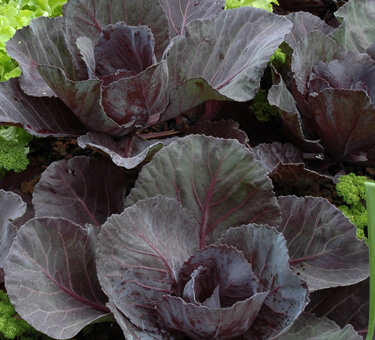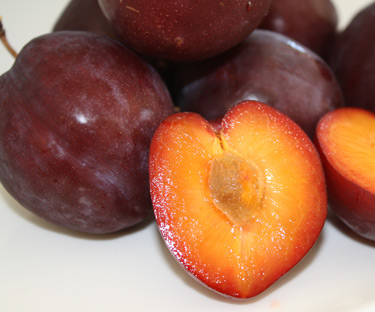The power of purple
Eye-catching fruits, edible flowers and vegetables with colourful leaves come in very handy when making a garden that’s as beautiful as it is productive. Plants with purple accents work especially well with greens.
The colour purple was once a symbol of great power and majesty. Queen Elizabeth I forbade anyone who wasn’t royal from wearing it. Few could afford it anyway as purple was extremely rare back in the days when fabric dyes came only from nature. Interestingly, the royal hue is also the most powerful wavelength of visible light.
In the plant world, the colour purple comes mainly from the anthocyanin group of pigments. Anthocyanins give us blues, purples and also the cooler shades of pink or red we see in flowers, fruits and veges. They also contain phytonutrients credited with significant potential health benefits. A growing body of research supports the notion that the pigments which give our food plants their beautiful colours could also be helping to prevent life-shortening diseases such as cancer, heart disease and brain disorders.
Ideally eat your purple fruits and veges as fresh and raw as possible. Among the most sensitive of plant pigments, anthocyanins are affected by heat and they dissolve easily in water, which is why purple veges like beans and broccoli turn green when cooked. Anthocyanins are also sensitive to pH, which is why cabbages and hydrangeas will turn more pink than purple in acidic soil, and why too much baking powder
in blueberry muffins can turn the berries green.
More science is needed before we can be sure that anthocyanins are as effective at fighting disease inside our bodies as they are in the test tube, but there is no doubt that purple packs a powerful punch from many fronts - and you don’t have to be royal to enjoy it. Especially when you grow your own!
Purple brassicas
Autumn is a great time to plant purple cabbage, purple broccoli and purple cauliflower. Purple kale and bright violet coloured kohlrabi are also fun to try. In warm moist soil, roots establish quickly and growth gathers momentum before winter sets in. Cool weather around harvest time is a good thing however, as plummeting temperatures transform starch into sugars. While white butterflies and diamond back moths are still fluttering around in warm autumn air, you can cover vulnerable young seedlings with bug net to protect them from late season caterpillars.
Radicchio
Also known as red chicory, radicchio is a beautiful brightly coloured vegetable worth growing for looks alone, but its peppery leaves make wonderful addition to autumn salads. It is also fantastic in stir fries and the pungent flavour will mellow with cooking. Roasted chicory root is used as a caffeine-free coffee substitute.
Radishes
Quick and easy radishes give crunch and colour to salads. They also make a healthy snack with dips. Sow seed directly into the garden soil or containers.
Red onions
Autumn is planting time for onions and spring onions. Chives are essential in any decorative herb garden, with purple pompom flowers (also edible) providing a lasting splash of colour.
Purple carrots
A few centuries ago most carrots were purple, and these days they’re making a comeback. Purple carrots contain most of the same pigments and health benefits as orange carrots, but have an extra helping of anthocyanins. Autumn is a good time to sow carrot seed into loose, well drained soil. Ideally sow carrots into soil that previously had a well fertilised crop of leafy greens. Go easy on nitrogen fertiliser as this can lead to forked carrots. Water to keep the soil moist, especially during the hotter weeks of early autumn.
Blueberries
Blueberries fit well into a smaller garden and make a great hedge. A great range of blueberry varieties is now available with varieties to suit every climate.Plant different varieties for cross-pollination and to spread the harvest season through summer and autumn. Plant them in moist, well drained soil with plenty of peat or compost added. Blueberries benefit from feeding with acidic (camellia and rhododendron) fertiliser. Bird netting is advisable at harvest time.
Blackberries
Blackberries have very levels of anthocyanins. The thornless variety ‘Black Satin’ has large glossy fruit and superb sweet flavour.
Grapes
Whether you make your own red wine or grow grapes for eating you are sure to be getting a good dose of anthocyanins. Red wine has the edge over white wine, because of the beneficial compounds found in grape skins. Red grapes to grow in the garden include the varieties Buffalo, Candice Seedless and Schuyler.
Pomegranate
Pomegranates boast high levels of antioxidants and vitamin C. The small shrub-like tree is a garden friendly size and drought tolerant once established. For best fruiting a long warm summer is needed.
Autumn vege planting
- Sow beetroot and carrots directly into well prepared garden soil or growing mix. Also sow swede in cooler climates.
- Sow broad bean seeds directly into the garden with stakes for support.
- Plant out brassicas (cabbage, broccoli, cauliflower, kale).
- Use insect mesh to protect young seedlings from caterpillar damage.
- Plant or sow onions, leeks, spring onions, lettuces, silver beet and spinach.
- Sow rocket for a quick supply of spicy autumn salad greens.

1-Mar-2019

Red cabbage

Boysenberries

Plum 'Lucy'

